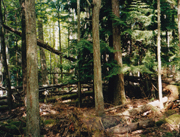 It started with the fire back in ‘04. Orcas loggers felled firs for cordwood to fuel the steamers. Live embers from a slash fire on the east end of Orcas flew across the water to Obstruction, igniting the island. It burned from end to end.
It started with the fire back in ‘04. Orcas loggers felled firs for cordwood to fuel the steamers. Live embers from a slash fire on the east end of Orcas flew across the water to Obstruction, igniting the island. It burned from end to end.
The deer and raccoons swam. The other small mammals were destroyed along with the forest. Standing hulks, looking like bombed out apartment buildings, are scattered over the island today. Someone digging in the ground may hit a long vein of charcoal where one of the 1904 giants lays buried. The old growth firs that survived the fire have deep burn scars carved into their thick bark.
 The deer and raccoons are back, but none of the others. There are no squirrels nor rabbits, no mice, rats, nor snakes. If any of these creatures hitch a ride to Obstruction, the resident eagles, ravens and owls prevent them from establishing a colony.
The deer and raccoons are back, but none of the others. There are no squirrels nor rabbits, no mice, rats, nor snakes. If any of these creatures hitch a ride to Obstruction, the resident eagles, ravens and owls prevent them from establishing a colony.
The deer didn’t reestablish themselves immediately. Obstruction hosts some of the handsomest groupings of big leaf maple in the county. Missing however are young maples to carry on the species. Each year on our property alone hundreds of little maples sprout from the whirling helicopter seeds. But by mid-summer the only ones left are those found in our fenced garden – the rest consumed in deer salads.
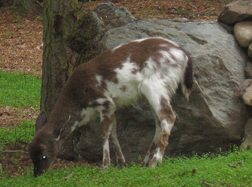
Proof that deer migrate between islands, besides tracks coming out of the water or an occasional deer spotted swimming, is our “pinto” deer. Those who drive on the east side of Orcas have noticed brown and white deer occasionally along the roads. Years ago they were on the north end of Moran. Gradually ones were seen nearer and then in Olga. Three years ago a “pinto” fawn was born on Obstruction Island. He is a now a handsome buck. A new one was born this year. Surprising is the similarity of markings on the Obstruction buck (above) and an Olga deer (below – both photos taken in June, 2008).

Obstruction Island is only 220 acres. It is cooler than Orcas in the summer and warmer in the winter. Many are the mornings when frost whitens Olga’s fields, yet the temperature hasn’t dipped below freezing on Obstruction. Wrapped in a tighter shawl of ocean, its temperatures stays more even.
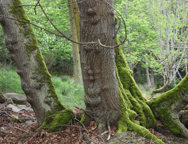 In spite of its small size, there are distinctly different ecological zones – similar to the other islands but more noticeable because they so closely abut one another. The northeast side boasts large alders and maples plus the usual cedar, fir and hemlock and a sizable portion of nettles. The long southeast side has pine not found on the rest of the island. Itsunderstory is thick with salal. This gives way grassy banks toward the south end. In the
In spite of its small size, there are distinctly different ecological zones – similar to the other islands but more noticeable because they so closely abut one another. The northeast side boasts large alders and maples plus the usual cedar, fir and hemlock and a sizable portion of nettles. The long southeast side has pine not found on the rest of the island. Itsunderstory is thick with salal. This gives way grassy banks toward the south end. In the 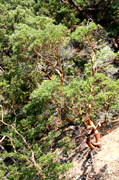 middle and along the west side are areas dense with hemlock here, cedar there, and always the fir – Douglas and white — interspersed with the large maples and mossy glens. Madronas cling to the dry western cliffs. On these cliffs, if you cut a fir only three inches in diameter, its rings will tell of a valiant existence of more than 70 years. Oregon grape has replaced the salal, plus foxgloves, – pink, purple and white.
middle and along the west side are areas dense with hemlock here, cedar there, and always the fir – Douglas and white — interspersed with the large maples and mossy glens. Madronas cling to the dry western cliffs. On these cliffs, if you cut a fir only three inches in diameter, its rings will tell of a valiant existence of more than 70 years. Oregon grape has replaced the salal, plus foxgloves, – pink, purple and white.
Obstruction has no blackberries. It has no scotch broom nor poison oak. Until about 8 years ago, there was no tansy ragwort. A small patch appeared at first. In spite of active pulling and bagging of the plants, it has continued to spread.
The island has also been undergoing changes similar to the other islands as more and more people build on their properties. Of the forty-eight waterfront properties that encircle the shared center, thirty now have cabins or homes. The question of the 21stcentury is whether the stewardship needed will be practiced so that the wilderness we seek to restore us is preserved.
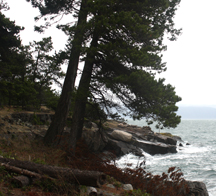
@2009 Caroline Buchanan
First published on August 19, 2009, in Project Home, a division of Sound Publishing, Inc. and circulated with The Islands’ Sounder, The Islands Weekly, and The Journal of the San Juans.
